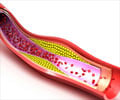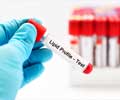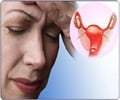Researchers show that a byproduct of cholesterol metabolism interferes with the beneficial effects estrogen has on the cardiovascular system.
Researchers show that a byproduct of cholesterol metabolism interferes with the beneficial effects estrogen has on the cardiovascular system.
This new finding by UT Southwestern Medical Center provides a better understanding of the interplay between cholesterol and estrogen in heart disease.The results of the study, available online and in the October issue of the journal Nature Medicine, also may explain why hormone replacement therapy fails to protect some postmenopausal women from heart disease, said Dr. David Mangelsdorf, chairman of pharmacology and senior author of the paper.
The researchers found that in rodents, a molecule called 27-hydroxycholesterol, or 27HC, binds to the same receptors in the blood vessels of the heart to which estrogen binds.
The normal result of this estrogen binding is that blood vessel walls remain elastic and dilated, and damage to the vasculature is repaired, among other heart-protective effects. Other research has shown that postmenopausal women – who no longer produce estrogen – lose this protective action and become more susceptible to heart disease.
Based on their animal studies and other experiments, the UT Southwestern researchers determined that when estrogen levels dropped relative to the amount of 27HC circulating in the blood, 27HC reacted and bound to the estrogen receptors in the cardiovascular system and blocked their protective function, primarily by inhibiting the production of nitric oxide. Nitric oxide mediates smooth muscle relaxation in blood vessels, aids cell growth and repair, and prevents thrombosis. Reduced levels of nitric oxide in blood vessels has been linked with high cholesterol and diabetes.
In animals fed a high-fat, high-cholesterol diet, both cholesterol and 27HC levels were elevated.
Advertisement
In normal premenopausal women, the amount of 27HC generated from cholesterol is relatively low compared to the level of estrogen circulating in the blood, leading to enhanced cardiovascular protection. In contrast, when the level of 27HC is higher relative to estrogen, such as during the postmenopausal period or as a consequence of high cholesterol, the researchers speculate that 27HC out-competes estrogen to bind with estrogen receptors, blocking the function of the receptors and resulting in a loss of protection.
Advertisement
The findings also may help explain why a large clinical trial that evaluated certain hormone replacement therapies (HRT) in postmenopausal women – a component of the 15-year Women’s Health Initiative – had to be halted in 2002 when the hormones appeared to increase a woman’s risk of heart disease.
“In the Women’s Health Initiative research program, the women who began taking HRT were an average of 13 years postmenopause,” Dr. Manglesdorf said. “By the time they started taking this estrogen again, the damage caused by 27HC binding to the estrogen receptors in the cardiovascular system may already have occurred. Once you lose estrogen’s protection for such an extended period of time, you can’t get it back.”
The researchers also found that 27HC works predominantly on estrogen receptors in the cardiovascular system. When it binds to estrogen receptors in other tissues, such as reproductive tissues, it has no effect on their reproduction-related functions. This property of 27HC makes it a “selective estrogen receptor modulator,” or SERM, the first such naturally occurring molecule known to exhibit such selectivity.
“This molecule is remarkable in its selectivity for the vasculature,” Dr. Mangelsdorf said. “These findings also validate the estrogen receptor as a possible drug target for manufactured SERMs.”
Source-Eurekalert
SPH/C











